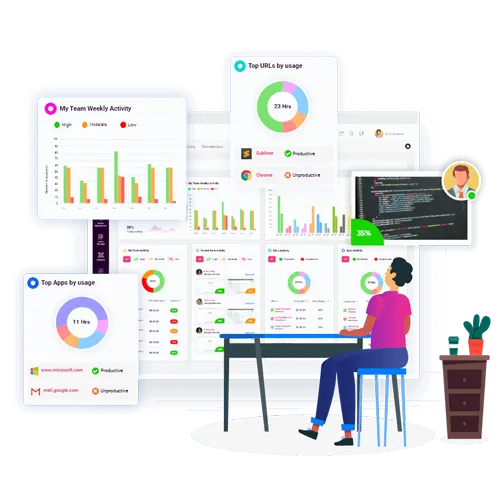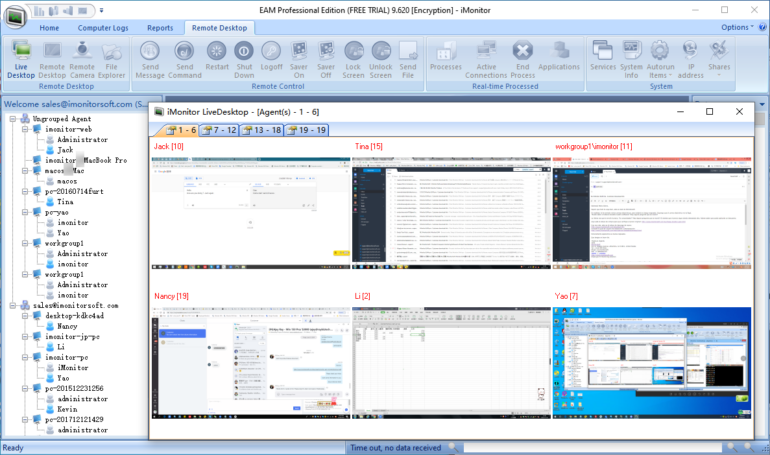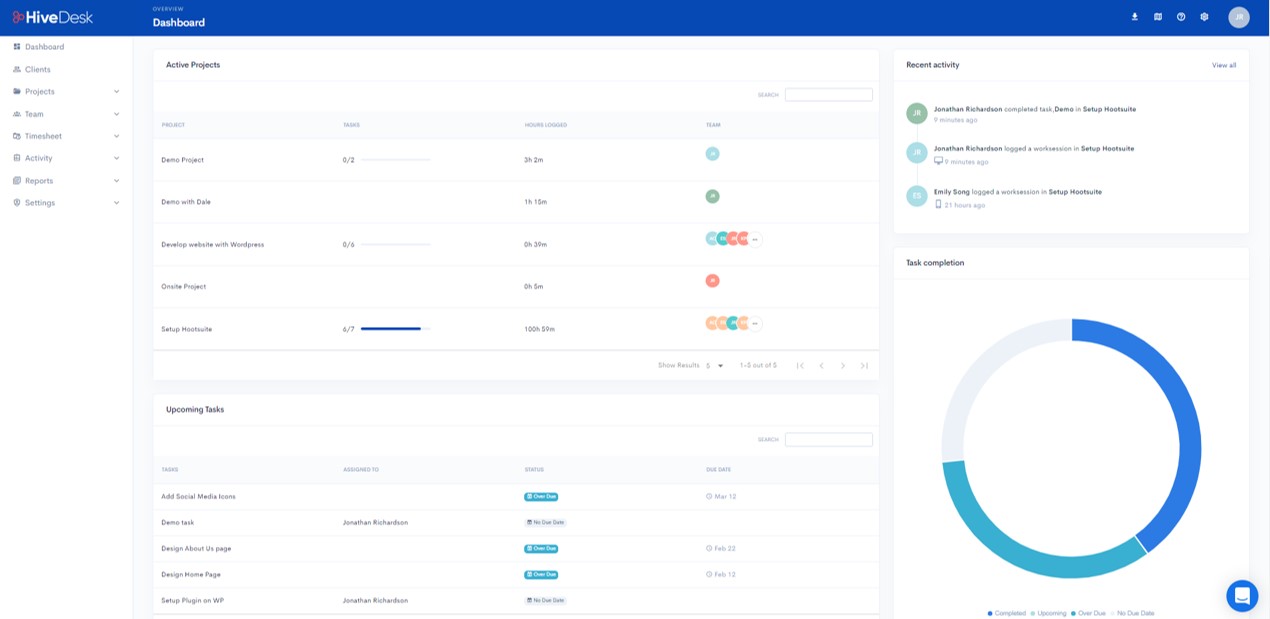It's a type of software that allows organizations to monitor, track and document the actions of their employees. Employers can collect data about various aspects of employee behaviour, including internet usage and app use. Keystrokes are also tracked as well as screen shots. Software to monitor employee activity is used primarily to improve productivity, check the compliance with company policies, safeguard sensitive information, and deal with security issues. When selecting an employee tracking software, there are a lot of aspects to take into consideration. Be aware of these key points: Features. Find the features you require based on your business's requirements. The most popular features are activity monitoring and blocking websites. Other features include keystroke logs and tracking software including email monitoring, and reports generation. Prioritize features that align with your goals for monitoring.
Compliance and Privacy- Ensure that the software follows the ethical and legal guidelines for employee monitoring. Learn about the applicable laws and regulations in your jurisdiction, such as privacy and data protection laws. Look for software that is transparency and adjustable privacy settings that protect the rights of employees.
User-Friendliness- Consider the software's simplicity of use and accessibility. Simple interfaces that are easy to use and simple set-up processes can speed up the process and simplify the implementation. Flexible dashboards and easy tools for reporting can help you to navigate through the data quickly.
Integration and Compatibility- Verify that the program is compatible with your existing IT infrastructure as well as the other systems you use including operating systems and email clients, as well as tools for managing projects, as well as collaboration platforms. Its compatibility allows for seamless monitoring without affecting day-today operations.
Data Security- Evaluate the software's security features to protect the data collected. It is essential to use encryption, secure data storage and access controls. Make sure that the company selling the software has a solid security record and reliable security practices for data.
Scalability- Take into consideration the capacity of the software to support the growth of your business. If you anticipate expanding your workforce or adding new locations, you should choose a software that is able to easily scale to meet your changing needs.
Analytics and Reporting Take a look at the software's reports and analytics features. Features that offer comprehensive insight into employee productivity, time management, and trends are essential to search for. Customized analytics and reports will aid you in identifying areas of improvement and help you make educated choices.
Customer Support: Assess the level of support offered by the software provider. Their availability, their level of support and response time are all crucial elements. If you've got a reliable customer service staff They will be able to offer quick help whenever issues arise.
Cost- Take a look at the pricing model of the software, whether it is a one-time payment, subscription-based, or usage-based. Know the pricing structure and any additional costs for support, upgrades, or other features. Your budget should be balanced and the value of features with the amount you are able to afford.
Employee Communication and Transparency- Establish clear communication with your employees about the implementation of software for monitoring. Transparently describe the purpose the scope, goals, and limitations of the monitoring. Discuss any concerns they may have, and assure them of confidentiality of their information.
When you look at these aspects, it is possible to make an educated decision that fits your organization's specific requirements and safeguards employees' privacy while meeting all lawful obligations. Have a look at the top rated time tracking monitoring software for website advice.

What Are The Distinct Aspects Of Employee Monitoring Software?
Software designed to monitor employee activity has numerous features that can be used to analyze and track the behavior of employees. Employee monitoring software may have various features. Here are some most commonly used features. Activity Monitoring The feature tracks and logs all employee activities such as the sites visited, the programs utilized, files accessed, and the time spent. It provides a thorough summary of what employees are doing at work.
Keystroke Logging: Keystroke logs track every single keystroke that employees make. It can detect productivity bottlenecks as well as detect unauthorized actions and collect evidence for investigations.
Screenshots and Screen Recordings Some programs take screen shots or record the screens of employees at regular intervals. This feature can be utilized to track the efficiency of employees, verify compliance, or to troubleshoot issues.
Internet Usage Tracking: This feature tracks employee internet activity, including websites visited, search downloads and queries. It helps identify excessive non-work-related internet browsing, security threats or violations of policies.
This feature tracks all apps employed by employees at work. It helps to identify unapproved and excessive application usage by providing insights into the apps that are used most often.
Email Monitoring - Email monitoring allows employers monitor employee emails to include sent and received messages as well as content from emails. It helps to ensure conformity with corporate policies, to prevent leakage of data and examine any suspicious behavior.
Document and File tracking This feature tracks access to, changes to, and transfers. It helps protect sensitive information and monitor collaborative work on documents and ensures compliance with the security guidelines for data.
Remote Monitoring: Employers have the ability monitor their employees remotely or who are at different locations. Employers can monitor their work and monitor productivity irrespective of their location.
Productivity Analysis – Employee monitoring software includes features for productivity analysis that give insights into employee patterns of work, time allocation and productivity levels. These analyses help identify areas that need improvement and can help to optimize workflow.
Reporting Analytics, Visualizations, and Reporting The powerful reporting and analysis features create rich reports and visual data from the data collected. These reports offer valuable insight into employee performance in time management, as well as the allocation of resources.
Compliance and Policy Management: Some software solutions include features that ensure conformity with the corporate regulations and industry standards. The software allows employers to set and enforce policies concerning acceptable use of computers as well as Internet access and data safety.
Alerts and Notifications - Alerts and notifications alert employees and managers to specific events and activities. For example they might alert employees about excessive Internet usage, attempts at accessing restricted websites, or other unsettling behaviors.
Be conscious that various employee monitoring systems might have different capabilities and features. When you choose a program, be certain that the features you select align with your monitoring goals as well as complying with any ethical or legal requirements applicable to your particular jurisdiction. View the top employee monitoring software for website recommendations.

What Software Is Used To Monitor Employee Performance? How Does It Adhere To Privacy And Privacy Law?
It is essential that software used to monitor employees conforms to compliance and privacy laws. Although the requirements for compliance and privacy will differ by state there are a few common methods that employees monitoring software complies with privacy and compliance regulations: Consent and Notice- Many areas require employees to provide informed consent and receive an advance notice of any monitoring activities. The tools used to monitor employees usually have options that permit employers to communicate with their employees in a clear manner. It may be necessary to provide written notices or obtain consent via consent forms. Also an employee handbook that outlines monitoring policies can also be implemented.
Transparent Monitoring Policy- Employee monitoring software encourages transparency, by ensuring that employees are aware of the different types of information collected as well as their intended use and the extent to which monitoring is carried out. Clear and comprehensive policies let employees know the limitations of monitoring as well as their privacy rights.
Data minimization is usually implemented by employee monitoring software to ensure the compliance of privacy laws. Data minimization implies that only the essential data is gathered, kept and discarded. By restricting data collection to only the necessary to be monitored, this software reduces the risk of privacy and encourages compliance.
Anonymization and Aggregation: Certain employee monitoring software anonymizes the data or combines it to safeguard privacy of employees. Anonymization eliminates all personally identifiable data (PII) and makes it impossible to link data to individuals. The aggregated data is a mix of several employees' data in order to get insights at a aggregate level, but without identifying specific individuals.
Secure Data Storage and Encryption - Software for monitoring employees puts a premium in the protection of the data stored. Secure encryption and data storage are used to protect the information from unauthorized access or disclosure by accident. This includes securing data both in transit and at rest.
Access Controls and Restricted permissions - Employee monitoring software provides access controls that are granular to ensure compliance. Employers can restrict access to monitor information to those who need it to fulfill legitimate requirements like HR employees and administrators designated by the company.
Rights of Employees Rights- Respecting employee's rights means ensuring compliance with privacy legislation. Employee monitoring software usually includes tools that allow employees to access and correct their own monitoring information and submit complaints. This allows employees to decide to take action and exercise their rights when they feel that privacy rights have been violated.
Compliance to Data Protection Regulations – Employee monitoring software is developed in accordance with applicable laws on privacy of data, including the General Data Protection Regulations (GDPR), in the European Union, or the California Consumer Privacy Acts (CCPA) in the United States. Compliance involves implementing security measures to protect data and respecting the rights of data subjects and ensuring the legality of processing.
In addition to employing tools for monitoring employees businesses should also seek out legal experts and keep up-to-date on laws and rules in their jurisdiction. Compliance and privacy laws requires a holistic approach that goes beyond the software itself, which includes explicit policies, education for employees, and ongoing compliance monitoring. Have a look at the most popular time tracking monitoring software for blog recommendations.
